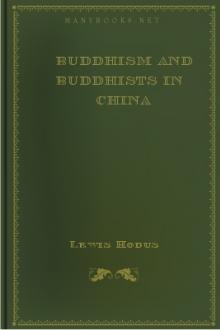Buddhism and Buddhists in China, Lewis Hodous [people reading books .TXT] 📗

- Author: Lewis Hodous
- Performer: -
Book online «Buddhism and Buddhists in China, Lewis Hodous [people reading books .TXT] 📗». Author Lewis Hodous
(c) Publications.—Quite as significant is the increase in the publication of Buddhist literature of all kinds. Many of the monasteries have printing departments where they publish the sutras needed for their own use. In addition, there are eight or more publishing centers where Buddhist literature is printed. The most famous are Yang’s establishment at Nanking, the Buddhist Press in Yangchow and that in Peking. In these establishments about nine hundred different works are being published. The most noteworthy recent publication has been that of the Chinese Buddhist Tripitaka in Shanghai.
Among these publications are a few modern issues. The Chung Hua Book Company has published several works on Buddhism. Other books have been issued for the sake of harmonizing Buddhism with western science and philosophy. In this enterprise Japanese influence is visible. In 1921 a Shanghai press published a dictionary of Buddhist terms containing 3302 pages, based on the Japanese Dictionary of Buddhism. Other works also show the influence of Japanese scholarship.
Among the publications have appeared two magazines. One published at Ningpo, is called “New Buddhism.” This is struggling and may have to succumb. The other is known as the “Sound of the Sea Tide,” now published in Hankow. Moreover, in all the large cities there are Buddhist bookshops where only Buddhist works are sold. These all report a good business. This literary activity reveals an interest among the reading classes of China. Few such books are purchased by the monks. The Chinese scholars read them for their style and for their deep philosophy, but also for light and for help in the present distracting political situation of their country.
(d) Lectures.—Along with publication goes the spread of Buddhism by lectures in the monasteries and the cities of China. A few years ago Buddhist sermons, however serious, were only listened to by monks and by a few pious devotees. Today such addresses are advertised and are usually well attended by the intellectuals. Often many women are found listening. Monks like T’ai Hs� and Yuan Ying have a national reputation. Not only monks, but laymen trained in Japan are delivering lectures on the Buddhist sutras. The favorites are the Awakening of Faith and the Suddharma Pundarika sutra.
(e) Buddhist Societies.—With the lectures goes the organization of Buddhist societies for all sorts of purposes. There is a central society in Peking which has branches in every province. The connection is rather loose. Buddhism has never been in favor of centralization. Nor for that matter would the government have allowed it. The chief ends aimed at by these societies are fellowship, devotion, study, propagation, and service. Such societies, often short lived, are springing up in many quarters. They meet for lectures on Buddhism or to conduct a study class in some of the sutras. Occasionally the more ambitious conduct an institute for several months. Some spend part of the time in meditation together. Several schools for children are supported by these societies. They also encourage work of a religious nature among prisoners, distributing tracts and holding services. Such activities are especially appreciated by those who are to suffer the death penalty. The societies are also doing publishing work. The two magazines are supported by the members of the larger societies.
(f) Signs of Social Ambition.—Social work is a prominent feature of some of these Buddhist societies. They have raised money for famine stricken regions, have opened orphanages, and assist in Red Cross work. One of the largest Chinese institutions for ministering to people who are sick and in trouble is located at Hankow. Around a central Buddhist temple is a modern-built hospital, an orphanage and several schools for poor children. It may not maintain western standards of efficiency, but it certainly represents the outreach of modern Buddhism.
Perhaps their most far-reaching advance has been made because of the realization that leaders are needed and that they must be trained. Several schools for this purpose have sprung into existence. Such schools are necessarily very primitive and are struggling with the difficulties of finding an adequate staff and equipment and of obtaining the best type of students.
Another sign of new life has been the making of programs for the future development of Buddhism. One of the most comprehensive appeared a short time ago. For the individual it proposes the cultivation of love, mercy, equality, freedom, progressiveness, an established faith, patience and endurance. For all men it proposes (1) an education according to capacity; (2) a trade suited to ability; (3) an opportunity to develop one’s powers; (4) a chance for enlightenment for all. For society it urges the cultivation of cooperation, social service, sacrifice for the social weal, and the social consciousness in the individual. On behalf of the country it urges patriotism, participation in the government, and cooperation in international movements. For the world it advocates universal progress. As to the universe it specifies as a goal the bringing of men into harmony with spiritual realities, the enlightenment of all and the realization of the spiritual universe.
A Buddhist writer sums up the aims of new Buddhism as follows:
“Formerly Buddhism desired to escape the sinful world. Today Buddhism not only desires to escape this world of sin, but longs to transform this world of sin into a new world dominated by the ideals of Buddhism. Formerly Buddhism was occupied with erecting and perfecting its doctrines and polity as an organization. Today it not only hopes to perfect the doctrines and polity, but desires to spread the doctrines and ideals abroad so as to help mankind to become truly cultured.”
4. The Attitude of Tibetan LamasNot only the Chinese Buddhists, but the Lamas of Mongolia and Tibet are feeling the impulses of the new age. Quite recently an exhibition was held in the Lama temple at Peking which attracted thousands of visitors. Its object was to obtain money to repair the temple, and thus to give its work a fresh impulse. That these impulses are not necessarily hostile to Christianity is shown by a letter written by the Kurung Tsering Lama of Kokonor district to the Rev. T. S�rensen of Szechuan:
“I, your humble servant, have seen several copies of the Scriptures and, having read them carefully, they certainly made me believe in Christ. I understand a little of the outstanding principles and the doctrinal teaching of the One Son, but as to the Holy Spirit’s nature and essence, and as to the origin of this religion, I am not at all clear, and it is therefore important that the doctrinal principles of this religion should be fully explained, so as to enlighten the unintelligent and people of small mental ability.
“The teaching of the science of medicine and astrology is also very important. It is therefore evident if we want this blessing openly manifested, we must believe in the religion of the only Son of God. Being in earnest, I therefore pray you from my heart not to consider this letter lightly. With a hundred salutations.”
Enclosed with this letter was a poem written in most elegant language.
“O thou Supreme God and most precious Father, The truth above all religions, The Ruler of all animate and inanimate worlds! Greater than wisdom, separated from birth and death, Is his son Christ the Lord shining in glory among endless beings. Incomprehensible wonder, miraculously made! In this teaching I myself also believe—As your spirit is with heaven united, My soul undivided is seeking the truth Jesus the Savior’s desire fulfilling, For the coming of the Kingdom of Heaven I am praying. Happiness to all.”
5. The Buddhist World Versus the Christian WorldLooking back over the last twenty-five years we see rising quite distinctly a Buddhist world growing conscious of itself, of its past history and of its mission to the world. This Buddhist, world has much more of a program than it had twenty-five years ago. Its object is to unite the Mahay�na and the H�nay�na branches of Buddhism and to spread Buddhist propaganda over the world. At present the leadership of this movement is in Japan. It is in part a political movement. There is no question that Christianity is not at all pleasing to the Japanese militarists. It is regarded by them as the advance post of western industrialism and political ambition. Quite naturally such leaders desire to make the Buddhist world a unit. It is also a social movement. The spirit of the Japanese Buddhist has been brought to consciousness by the new position of Japan. Japan is seeking to take its place in the world as a first rate power. By this not only will Japan’s industry and commerce profit, but its spiritual values must also be adapted to the world. The movement then has its spiritual side. Japanese travelers and people are going to all parts of the world. They carry with them the religious ideals which have been shaped by Buddhism. Buddhism in the past was one of the great religions of salvation with an inspiring missionary message. It is again awakening to this task of evangelization. Under the leadership of Japanese scholars and religious statesmen the Japanese are seeking to unite the Buddhist world so that it shall become a force in the new world. Japan is thus trying to give back what it has received in the past.
At present in Buddhist countries there is a strong force working against this movement. Nationalism is a new force to be reckoned with. Still even with the spirit of nationalism permeating every group, the Buddhist world is getting together and will strive to make its contribution to the life of the whole world.
X
THE CHRISTIAN APPROACH TO BUDDHISTS
1. Questions Which Buddhists AskBuddhists are approaching Christianity. In many places a spirit of inquiry and interest in the Christian religion is met. It is not necessary that there should be a Buddhist world permanently over against a Christian world. The questions which Buddhists ask a missionary indicate an interest in vital themes. Some of them are as follows:
We put our trust in the three Precious Ones. In what do you trust? Is not your Shang Ti (name for God used in China) a being lower than Buddha and just a little higher than a Bodhisattva? Is not Shang Ti the tribal god of the Jews? Do you believe in the existence of purgatory? What sufferings will those endure who do not live a virtuous life? Do you believe in the reality of the Western Paradise? How can one enter it? There being three kinds of merit, by what method is the great merit accumulated? How is the middle and the small merit accumulated? What are the fruits of these proportions of merit and what are they like? Tell me how to believe Christ. What work of meditation do you perform? Is not Buddhism more democratic than Christianity, because it holds out the possibility of Buddhahood to all beings? Is not Buddhism more inclusive, because it provides for the salvation of all beings?
2. Knowledge and SympathyThese questions make it plain that the worker who is to deal with Buddhists should have a broad background of general culture. He must be thoroughly humanized. He should have a good knowledge of the history of philosophy and religion, including the work of the modern philosophers. A knowledge of the life of Buddha and of the doctrines of the H�nay�na or Southern Buddhism, as well as the tenets of the Mahay�na should be in his possession. The psychology of religion should interpenetrate his historical learning; the best





Comments (0)